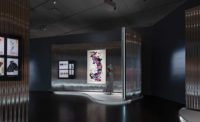Now that snow has finally melted in the Mile High City, construction crews are preparing to start permanent repairs on the roof of the new Frederic C. Hamilton wing at the Denver Art Museum. The roof began leaking as a result of record-breaking snowfalls this winter.
After unveiling the long-awaited 146,000-sqaure-foot addition last fall, trustees, staff, and patrons thought they’d seen the last of construction crews for a while. But only weeks after the Hamilton wing’s grand opening on October 7, a massive storm dumped nearly two feet of snow and gave the new structure its first real test of severe weather. Much to their disappointment, museum officials discovered water leaking from the roof and skylights in the El Pomar Grand Atrium. This soaring, 120-foot-high space serves as the main lobby for the galleries and is best known for its sloped walls and a spiraling, four-story staircase.
The building’s architects, a joint venture between Studio Daniel Libeskind and Davis Partnership Architects, worked with teams from the construction firm M.A. Mortenson to inspect the atrium’s roof, which is composed of structural steel and a metal deck clad in titanium panels. As part of a temporary fix, crews removed elevated beam covers and applied an additional waterproofing layer.
But another series of big storms in December complicated matters, making it difficult for investigators to locate the leak’s source. Construction crews added extra waterproofing to a wall on the atrium’s roof that was designed to prevent snow and water from overflowing down onto the building’s entrance. They also removed some interior drywall to aid in monitoring water movement on the roof’s interior underside.
“The problem is primarily on the atrium roof and its skylights, where there are issues with condensation and leaking,” says Brit Probst, a principal and partner at Davis Partnership Architects. “The exact causes are still being investigated and won’t be fully known until the existing roof is removed.”
Crews will likely replace much of the atrium’s existing roof, Probst adds. Though plans for a permanent solution are still in discussion, the museum hopes to have the problem resolved by the end of summer. The price tag for repairs is undisclosed at this time.
“It is absolutely unfortunate to have an issue, but I think we are lucky to have realized it at such an early point when all parties were still on-site and available to deal with it,” says Andrea Kalivas Fulton, a museum spokesperson.






Post a comment to this article
Report Abusive Comment